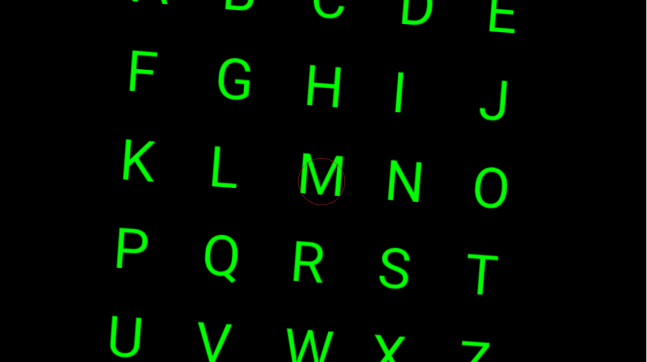TTS - Text to Speech - Ein Funktionstest für einen Sprachsynthesizer
(EN google-translate)
(PL google-translate)
 Sprachsynth002.zip
Sprachsynth002.zip

Bild 0-1: Screenshot der App.
Hinweise:
|
Sollte wegen verändertem Android-Betriebssystem das Flashen neuer Apps nicht funktionieren, kann noch ein Versuch mit adb gemacht werden. Siehe: Android->ADB_apps.
import processing.vr.*;
import android.speech.tts.TextToSpeech;
import java.util.Locale;
import java.util.Set;
import android.media.AudioManager;
import android.content.Context;
//ACHTUNG:
//Android->VR anhaken
PMatrix3D eyeMat = new PMatrix3D();
TTS tts;
String zeichen = "ABCDEFGHIJKLMNOPQRSTUVWXZ";
int RESTZEIT = 0;
String[] AUSWAHL = {"1","2","3"};
int inx=0;
void setup()
{
fullScreen(MONO);
tts = new TTS();
tts.setzeSpechgeschwindigkeit(1.0f);
tts.setzeStimmhoehe(1.0f);
tts.setzeLautstaerke(0.8f);
}
void draw()
{
//Standardeinstellungen für unser Arbeiten:
background(0);
getEyeMatrix(eyeMat); //Kameramatrix auslesen
translate(eyeMat.m03, eyeMat.m13, eyeMat.m23); //Welt in Koordinatenursprung von Kamera setzen.
lights();
float ez_x = eyeMat.m02; //Einheitsvektor der aktuellen Blickrichtung
// float ez_y = -eyeMat.m12;
float ez_y = eyeMat.m12;
float ez_z = eyeMat.m22;
//ENDE Standardeinstellungen für unser Arbeiten:
//Buchstaben auf "Platten" zeichnen:
textSize(64);
for(int i=0;i<zeichen.length();i++)
{
pushMatrix();
float z = -500.0f;
float y = - 200 + (i/5)*100;
float x = 100*(i%5) - 200;
//Nähe zum Zielkreis:
//1) Einheitsvektor bilden:
float laenge = sqrt(x*x+y*y+z*z);
float xx=x/laenge;
float yy=y/laenge;
float zz=z/laenge;
//2) Skalarprodukt mit Blickrichtung (ez)
float sk = xx*ez_x + yy*ez_y + zz*ez_z;
if(sk>0.99f && RESTZEIT==0)
{
AUSWAHL[inx]=zeichen.substring(i,i+1);
inx++;
inx%=AUSWAHL.length;
if(AUSWAHL[0].equals(AUSWAHL[1]) && AUSWAHL[1].equals(AUSWAHL[2]))
{
tts.sprich(AUSWAHL[0]);
AUSWAHL[0] ="1";
AUSWAHL[1] ="2";
AUSWAHL[2] ="3";
}
RESTZEIT = 30;
}
translate(x,y,z);
noStroke();
/*
fill(200.0f,200.0f,200.0f);
rect(-40, -40, 80, 80);
translate(0,0,5);
*/
fill(0,255,0);
text(zeichen.substring(i,i+1),-20,20);
popMatrix();
}
//Zielkreis zeichnen
eye(); //Transformation realtiv zur Kamera
translate(0, 0, 95); //Zielkreis relativ zur Kamera zeichnen
noFill();
stroke(255,0,0);
ellipse(0, 0, 10, 10);
if(RESTZEIT>0)
RESTZEIT--;
}
Code 0-1: Sprachsynthese002.pde
public class TTS
{
TextToSpeech tts;
AudioManager audio;
int currentVolume;
int maxVolume;
public void setzeSpechgeschwindigkeit(float s)
{
tts.setSpeechRate(s);
}
public void setzeStimmhoehe(float h)
{
tts.setSpeechRate(h);
}
public void setzeLautstaerke(float ls)
{
if(ls<0.0f)
ls=0.0f;
if(ls>1.0f)
ls=1.0f;
int LAUT = (int) (maxVolume*ls);
audio.setStreamVolume(AudioManager.STREAM_MUSIC, LAUT, 0);
}
public void sprich(String text)
{
if(tts!=null)
{
tts.speak(text, TextToSpeech.QUEUE_FLUSH, null);
println("tts: \""+text+"\"");
}
else
{
println("tts==null");
}
}
public TTS()
{
//NEU: getActivity(). ab Proc. 3!
tts=new TextToSpeech(getActivity().getApplicationContext(), new TextToSpeech.OnInitListener() {
//@Override
public void onInit(int status) {
if(status != TextToSpeech.ERROR) {
tts.setLanguage(Locale.GERMAN);
}
}
});
audio = (AudioManager) getActivity().getSystemService(Context.AUDIO_SERVICE); //NEU: getActivity(). ab Proc. 3!
currentVolume = audio.getStreamVolume(AudioManager.STREAM_MUSIC);
maxVolume = audio.getStreamMaxVolume(AudioManager.STREAM_MUSIC);
}
}
Code 0-2: TTS.pde
Übung
|